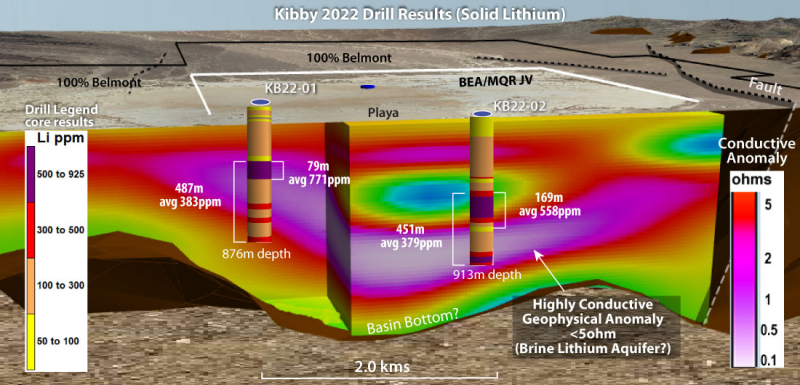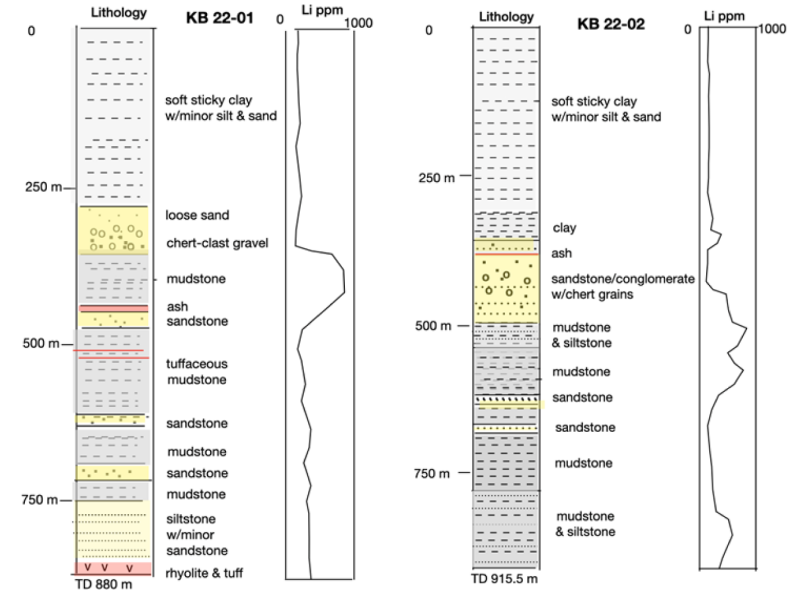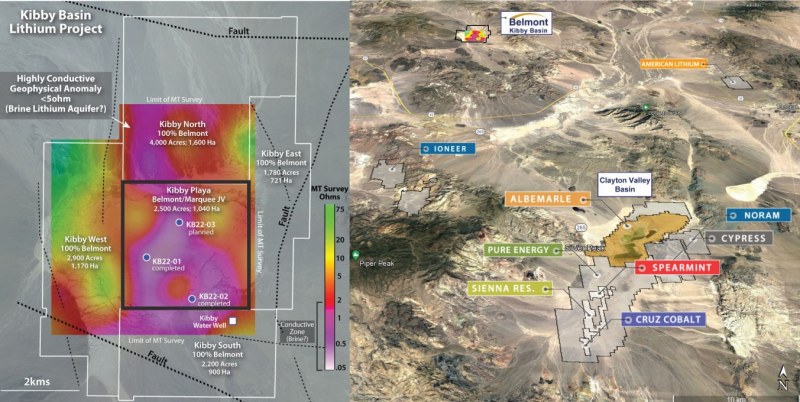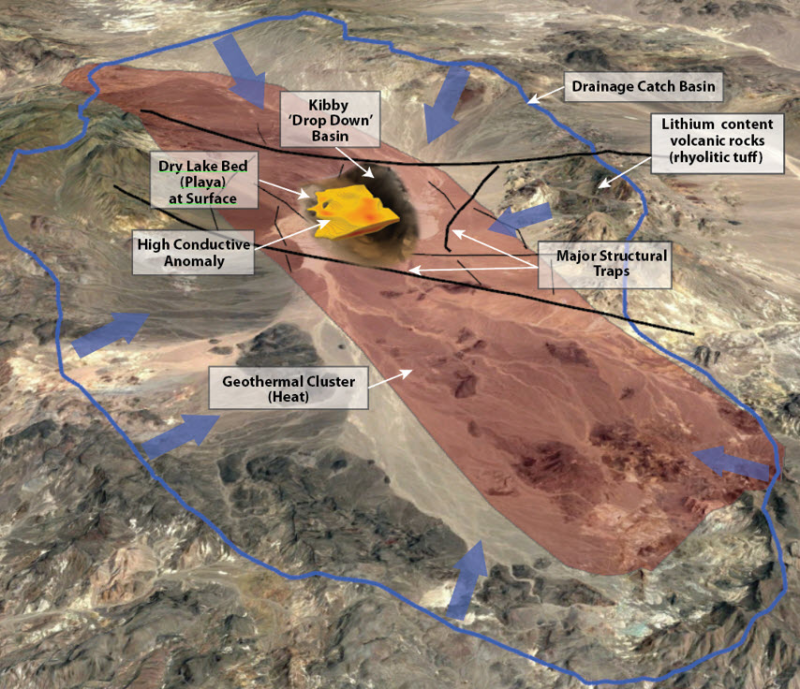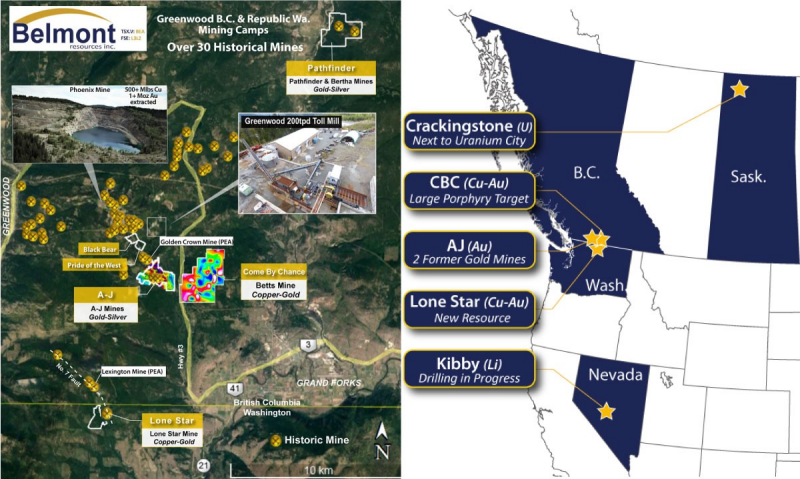Belmont Resources' JV partner Marquee Resources intercepts thick lithium bearing sediments at Kibby Basin, Nevada
(TheNewswire)
 | |||||||||
 | |||||||||
HIGHLIGHTS:
-
The Company has successfully tested the magnetotelluric anomaly at the Kibby Basin Lithium Project and the results from two boreholes (KB 22-01 and KB 22-02) have confirmed high levels of lithium-bearing sediments along with dissolved lithium in the groundwater.
-
Mineralised intervals containing up to 924 ppm lithium with greater than 300 ppm lithium over thicknesses in excess of 450m (1475 ft) have been identified in core samples of clay-rich playa sediments.
-
Lithium mineralization is fairly consistent in both thickness and grade in the two boreholes, which are 2,000 m apart, suggesting extensive lateral occurrence across the basin
-
Drill hole KB 22-01
-
Assay results of drill core returned lithium solids concentrations of up to 924 ppm Li with mineralisation open at depth.
-
Below the contact between unconsolidated lakebed sediments and more lithified sediments, lithium content increased significantly and drilling intersected a 79 m (260 ft) thick section from 362-441 m (1188-1448 ft) averaging 771 ppm Li with a high of 924 ppm Li
-
The upper high lithium zone was contained within a very thick zone, averaging 383 ppm Li over 487 m (1597 ft) continuing to the bottom of the hole. The lithium mineralisation is open at depth.
-
Dissolved lithium was identified in the groundwater at depths generally correlating with the lithium bearing sediments.
-
-
Drill hole KB 22-02
-
Encountered anomalous lithium values above the hard gravel and significant lithium enrichment below - with all mineralisation remaining open at depth.
-
A thick zone of 169 m (555 ft) averaging 558 ppm Li with a high of 860 Li lay below the contact.
-
Lithium mineralisation continued to the bottom of the hole with an average of 379 ppm Li over 451m (1478 ft) continuing to the bottom of the hole. The lithium mineralisation is open at depth.
-
-
Following these significant results, Marquee has commenced planning for a 2023 drill campaign designed to establish a JORC resource over the project.
Vancouver, B.C. Canada – TheNewswire - December 8, 2022 - Belmont Resources Inc. (“Belmont”), (or the “Company”), (TSXV:BEA); (FSE:L3L2) welcomes the news that its joint venture partner Marquee Resources Limited (ASX: MQR) (“MQR or The Company”) announce results from its Kibby Basin Lithium Project 2022 drill campaign. Assay results received indicated thick sequences of lithium-bearing sediments at the Project, with up to 924 ppm Li from the two exploration boreholes (KB 22-01 and KB 22-02) that were completed.
Core Assay Results
Hole KB 22-01 was drilled as a vertical borehole to a depth of 880 m (2888 ft). The hole was drilled as an air-core pre-collar to a depth of 329 (1080 ft), followed by HQ core, reduced to NQ core at 408 m (1338 ft).
As expected, analysis of cuttings from the upper non-core section of the hole indicated weakly anomalous lithium content, ranging from a few 10s of ppm to 154 ppm Li. Drilling switched to core immediately below a hard gravel unit, which forms the boundary between unconsolidated pluvial-fluvial sediments and partially lithified equivalents with substantial tuffaceous (ash) content below. A representative sampling of approximately 10% of the core was split in half using a diamond saw and one split was delivered to Paragon Geochemical in Sparks, NV, an ISO/IEC 17025-2017 certified laboratory, for 31-element ICP analysis, including lithium.
Lithium content increased significantly below the contact, with a 79 m (260 ft)-thick section from 362-441 m (1188-1448 ft) averaging 771 ppm Li with a high of 924 ppm Li. The upper high lithium zone was contained within a very thick zone, averaging 383 ppm Li over 487 m (1597 ft) continuing to the bottom of the hole. The lithium mineralisation is open at depth.
Hole KB 22-02 was drilled as a vertical borehole to a depth of 915.6 m (3004) ft. Similar to the first hole, KB 22-02 was drilled as a mud-rotary pre-collar to a depth of 366 m (1200 ft), followed by HQ and NQ core.
As with the first hole, KB 22-02 encountered anomalous lithium values above the hard gravel and significant lithium enrichment below. A 169 m (555 ft)-thick zone averaging 558 ppm Li with a high of 860 Li lay below the contact. Lithium mineralisation continued to the bottom of the hole with an average of 379 ppm Li over an interval of 451 m (1478 ft). Mineralisation remains open at depth.
Both KB 22-01 and KB 22-02 were drilled to test a thick MT conductor. The start of the high lithium zone in both holes corresponds with the approximate top of the conductor. Neither hole drilled to the bottom of the conductor or the bottom of the potential aquifer zone within the playa-filling sediments.
The results of the core sampling are presented in Table 1.
Preliminary Groundwater Assay Results
Hole KB 22-01 was sampled for lithium-bearing groundwater in the pre-collar interval to a depth of 329 (1080 ft), and the HQ and NQ core intervals to 408 m (1338 ft). Twenty-three intervals were sampled including two long interval, large purge-volume samples and a duplicate for QA. Sample intervals were purged of drilling fluids and cuttings prior to sampling. The general chemical parameters of water samples were measured at the time of collection using a multiparameter chemistry meter. Samples were then sent to a laboratory where they were analysed for a wide range of total and dissolved metals, anions, and general parameters.
Samples from twelve intervals of the upper non-core section of the hole were by means of airlifting groundwater from a short interval of exposed borehole. The non-core hole samples were delivered to ALS Geochemistry in Reno, NV, an ISO 45001-2018 certified laboratory, for 53-element ultra-trace ICP analysis. Eleven samples from the lower core hole were sampled using a large-volume bailer lowered to targeted depths. The core hole samples were delivered to Western Environmental Testing Loratories (WETLAB) in Sparks, NV, a Nevada Division of Environmental Protection accredited laboratory, for 34-element ICP analysis, select anion by Ion Chromatography, and general chemistry analyses.
ALS results from the non-core upper portion of the hole indicated dissolved content up to 0.15 mg/L at 208 m (685 ft). Dissolved lithium content in the eleven WETLAB samples collected in the lower core hole below the gravel unit was below detection levels.
Hole KB 22-02 was sampled for lithium bearing groundwater in the HQ and NQ intervals from 366 m (1200 ft) to 915.6 m (3304 ft). Thirty-six samples were collected and analysed; including several resampled intervals to confirm results and a long interval, large purge volume sample. Sample intervals were purged of drilling fluids and cuttings prior to sampling. The general chemical parameters of water samples were measured at the time of collection using a multiparameter chemistry meter. Samples were then sent to WETLAB, where they were analysed for a wide range of total and dissolved metals, anions, and general parameters.
The lower portion of the KB 22-02 below 817 m (2682 ft) drilled through relatively competent formation material and was sampled by means of a straddle packer system across three intervals. Two samples were from purge water with anomalous chemistry readings. The remaining thirty-one samples were collected using a large-volume bailer lowered to targeted depths following core hole purging.
Twenty-nine water samples were delivered to WETLAB in Sparks, NV for 34-element ICP analysis, select anion by Ion Chromatography, and general chemistry analyse.
The preliminary results of the water sampling from KB 22-01 and KB 22-02 are presented in Table 2 and Table 3, respectively.
Summary1
The Kibby Basin Lithium Project is a highly prospective asset located within a 60km radius of North America’s only producing Lithium mine, owned by the world’s largest Lithium producer, Albemarle. The Kibby Project contains potentially favourable conditions for the development of lithium‐rich brines and sediments and has similar features as Clayton Valley which hosts Albemarle Silver Peak Lithium mine.
Adding further excitement to the 2,560 acres (~10sqkm) project is the fact the Project is fully permitted for water extraction for brine processing and production of lithium compounds - a very scarce commodity in the immediate area and will prove extremely valuable should the initial exploration success lead to lithium production.
The company is buoyed by the 7.4km long structure identified in Kibby Valley with characteristics interpreted to be akin to major structures bounding the south side of Clayton Valley, that forms a pull-apart drop-down closed basin within a 700sqkm drainage catch basin.
Location
The Kibby Basin Lithium Project is located 60kms north of Clayton Valley, Nevada which hosts the sole North American producing Lithium mine (Silver Peak Lithium) owned by the world’s largest Lithium producer, Albemarle. Marquee’s 100% owned Clayton Valley Lithium Project also sits in the Clayton Valley.
Kibby Basin claims and ownership. Kibby Basin Lithium Project Location in relation to Clayton Valley.
Property Geology
The Kibby Basin Lithium Project has similar features as Clayton Valley, Nevada and contains potential favourable conditions for the development of lithium‐rich brines and sediments such as; an arid climate, major catch basin, basin has structural traps and is closed, associated igneous or geothermal activity, suitable lithium source rocks and one or more adequate aquifers.
-
-
-
Arid Climate
-
Pull‐apart drop-down closed basin
-
700 sq. kms drainage catch basin
-
Basin has structural traps and is closed
-
Associated igneous or geothermal activity
-
Suitable lithium source rocks
-
Permitted for Water
-
-
Geological highlights of the Kibby Basin that make it potentially favourable to the development of Lithium-rich brines and sediments:
Table 1
Core sampling results
|
KB22-02 |
||||||||
|
From |
To |
Sample length |
Li |
From |
To |
Sample length |
Li |
|
|
(m) |
(m) |
(m) |
ppm |
(m) |
(m) |
(m) |
ppm |
|
|
cuttings samples |
cuttings samples |
|||||||
| 0 |
6.1 |
6.1 |
70 |
|||||
|
6.1 |
12.2 |
6.1 |
80 |
|||||
|
12.2 |
18.3 |
6.1 |
80 |
|||||
|
18.3 |
24.4 |
6.1 |
80 |
|||||
|
24.4 |
30.5 |
6.1 |
80 |
|||||
|
30.5 |
36.6 |
6.1 |
100 |
|||||
|
36.6 |
42.7 |
6.1 |
100 |
|||||
|
42.7 |
48.8 |
6.1 |
140 |
|||||
|
48.8 |
54.9 |
6.1 |
110 |
24.4 |
30.5 |
6.1 |
65 |
|
|
54.9 |
61 |
6.1 |
100 |
54.9 |
61.0 |
6.2 |
65 |
|
|
61 |
67.1 |
6.1 |
90 |
85.3 |
91.4 |
6.1 |
75 |
|
|
67.1 |
73.2 |
6.1 |
80 |
115.8 |
121.9 |
6.1 |
96 |
|
|
73.2 |
79.3 |
6.1 |
40 |
146.3 |
152.4 |
6.1 |
110 |
|
|
79.3 |
85.4 |
6.1 |
100 |
176.8 |
182.9 |
6.1 |
136 |
|
|
85.4 |
91.5 |
6.1 |
90 |
207.3 |
213.3 |
6.1 |
144 |
|
|
103.6 |
109.7 |
6.1 |
143 |
230.3 |
236.4 |
6.1 |
119 |
|
|
134.1 |
140.2 |
6.1 |
122 |
268.2 |
274.3 |
6.1 |
135 |
|
|
164.6 |
170.7 |
6.1 |
132 |
286.5 |
289.5 |
3.0 |
130 |
|
|
237.7 |
243.8 |
6.1 |
141 |
298.7 |
304.8 |
6.1 |
106 |
|
|
298.7 |
304.8 |
6.1 |
154 |
317.0 |
320.0 |
3.0 |
161 |
|
|
317.0 |
323.1 |
6.1 |
64 |
329.2 |
335.3 |
6.1 |
165 |
|
|
317.0 |
323.1 |
6.1 |
53 |
359.6 |
365.7 |
6.1 |
139 |
|
|
split core samples |
split core samples |
|||||||
|
362.1 |
364.2 |
2.1 |
682 |
365.7 |
368.2 |
2.4 |
318 |
|
|
408.3 |
413.4 |
5.1 |
810 |
380.4 |
383.1 |
2.7 |
90 |
|
|
413.8 |
416.9 |
3.1 |
924 |
415.4 |
418.5 |
3.0 |
105 |
|
|
438.1 |
441.3 |
3.2 |
917 |
427.9 |
430.7 |
2.7 |
108 |
|
|
471.7 |
474.9 |
3.2 |
523 |
462.7 |
465.7 |
3.0 |
494 |
|
|
505.2 |
508.4 |
3.2 |
151 |
496.2 |
499.2 |
3.0 |
510 |
|
|
529.6 |
532.8 |
3.2 |
103 |
525.4 |
527.6 |
2.1 |
860 |
|
|
564.9 |
571.2 |
6.3 |
186 |
555.0 |
558.1 |
3.0 |
539 |
|
|
587.4 |
590.7 |
3.3 |
219 |
586.1 |
587.6 |
1.5 |
768 |
|
|
636.2 |
639.4 |
3.2 |
202 |
629.1 |
631.8 |
2.7 |
345 |
|
|
684.6 |
687.9 |
3.3 |
362 |
647.7 |
650.7 |
3.0 |
138 |
|
|
663.8 |
666.9 |
3.1 |
251 |
678.8 |
681.0 |
2.3 |
89 |
|
|
684.9 |
687.9 |
3.0 |
255 |
708.6 |
710.8 |
2.1 |
144 |
|
|
770.3 |
773.5 |
3.2 |
356 |
751.9 |
755.0 |
3.0 |
192 |
|
|
753.7 |
755.9 |
2.2 |
115 |
772.3 |
775.1 |
2.7 |
188 |
|
|
770.5 |
773.5 |
3.0 |
294 |
809.2 |
812.3 |
3.1 |
200 |
|
|
813.2 |
815.6 |
3.1 |
296 |
833.0 |
836 |
3.0 |
411 |
|
|
849.7 |
852.8 |
3.0 |
324 |
868.9 |
872 |
3.1 |
501 |
|
|
873.2 |
876.3 |
3.1 |
311 |
910.1 |
913.1 |
3.0 |
312 |
|
Table 2
Preliminary results of the water sampling KB22-01
|
Sample No. |
Depth (ft) |
Specific Conductivity |
Total Dissolved Solids |
Lithium - Dissolved |
Lithium - Total |
|
|
From |
To |
(μS/cm) |
(mg/L) |
(mg/L) |
(mg/L) |
|
|
KB22-01 No. 1 |
295 |
300 |
3200 |
2530 |
0.0395 |
NA |
|
KB22-01 No. 2 |
355 |
360 |
4780 |
3110 |
0.0549 |
NA |
|
KB22-01 No. 3 |
395 |
400 |
1330 |
860 |
0.1015 |
NA |
|
KB22-01 No. 4 |
415 |
420 |
1370 |
3440 |
0.0587 |
NA |
|
KB22-01 No. 5 |
455 |
460 |
2390 |
1540 |
0.0752 |
NA |
|
KB22-01 No. 6 |
495 |
500 |
5580 |
3620 |
0.0607 |
NA |
|
KB22-01 No. 7 |
555 |
560 |
6410 |
4150 |
0.0684 |
NA |
|
KB22-01 No. 8 |
680 |
685 |
1590 |
1030 |
0.15 |
NA |
|
KB22-01 No. 9 |
735 |
755 |
2450 |
1590 |
0.1275 |
NA |
|
KB22-01 No. 10 |
820 |
840 |
2320 |
1510 |
0.0792 |
NA |
|
KB22-01 No. 11 |
880 |
900 |
2730 |
1780 |
0.0776 |
NA |
|
KB22-01 No. 12 |
980 |
1000 |
1090 |
710 |
0.0558 |
NA |
|
KB22-01 No. 13 |
1124 |
1134 |
2254 |
1830 |
Pending |
Pending |
|
KB22-01 No. 14 |
1124 |
2888 |
2165.2 |
1850 |
Pending |
Pending |
|
KB22-01 No. 15 |
1194 |
1204 |
2005 |
1570 |
Pending |
Pending |
|
KB22-01 No. 16 |
1338 |
1348 |
3256 |
2690 |
Pending |
Pending |
|
KB22-01 No. 17 |
1338 |
2888 |
2956.6 |
2230 |
Pending |
Pending |
|
KB22-01 No. 18 |
1447 |
1457 |
2957 |
2270 |
Pending |
Pending |
|
KB22-01 No. 19 |
1687 |
1697 |
2939 |
2280 |
Pending |
Pending |
|
KB22-01 No. 20 |
1947 |
1957 |
2650 |
1930 |
Pending |
Pending |
|
KB22-01 No. 21 |
2207 |
2217 |
2834 |
1600 |
Pending |
Pending |
|
KB22-01 No. 22 |
2447 |
2457 |
3030 |
2090 |
Pending |
Pending |
|
KB22-01 No. 23 |
2787 |
2797 |
3225 |
2180 |
Pending |
Pending |
Table 3
Preliminary results of the water sampling KB22-02
|
Sample No. |
Depth (ft) |
Specific Conductivity |
Total Dissolved Solids |
Lithium – Dissolved Concentration |
Lithium – Total Concentration |
|
|
From |
To |
(μS/cm) |
(mg/L) |
(mg/L) |
(mg/L) |
|
|
KB22-02 No. 1 |
1198 |
1208 |
1888 |
1227 |
<0.1 |
0.116 |
|
KB22-02 No. 2 |
1208 |
1218 |
2009 |
1305 |
0.285 |
2.56 |
|
KB22-02 No. 3 |
1238 |
1248 |
1942 |
1262 |
0.227 |
1.18 |
|
KB22-02 No. 4 |
1308 |
1318 |
2049 |
1332 |
0.229 |
1.11 |
|
KB22-02 No. 5 |
1338 |
1348 |
2132 |
1386 |
0.235 |
1.04 |
|
KB22-02 No. 6 |
1378 |
1388 |
2176 |
1414 |
0.273 |
1.09 |
|
KB22-02 No. 7 |
1488 |
1498 |
2261 |
1470 |
0.295 |
1.18 |
|
KB22-02 No. 8 |
1528 |
1538 |
2321 |
1509 |
0.327 |
1.44 |
|
KB22-02 No. 9 |
1578 |
1588 |
2470 |
1605 |
0.338 |
2.37 |
|
KB22-02 No. 10 |
1628 |
1638 |
2665 |
1732 |
0.213 |
2.15 |
|
KB22-02 No. 11 |
1698 |
1708 |
3074 |
1998 |
0.355 |
5.29 |
|
KB22-02 No. 12 |
1728 |
1738 |
3200 |
2080 |
0.346 |
10.5 |
|
KB22-02 No. 13 |
1798 |
1808 |
3306 |
2149 |
0.279 |
27 |
|
KB22-02 No. 14 |
1848 |
1855 |
3384 |
2199 |
0.335 |
10.9 |
|
KB22-02 No. 15 |
2008 |
2018 |
3656 |
2377 |
Pending |
Pending |
|
KB22-02 No. 16 |
2028 |
2038 |
3618 |
2351 |
Pending |
Pending |
|
KB22-02 No. 17 |
2058 |
2068 |
3648 |
2371 |
Pending |
Pending |
|
KB22-02 No. 18 |
2098 |
2108 |
3238 |
2104 |
Pending |
Pending |
|
KB22-02 No. 19 |
2108 |
2118 |
3431 |
2230 |
Pending |
Pending |
|
KB22-02 No. 20 |
2248 |
2314 |
3063 |
1991 |
Pending |
Pending |
|
KB22-02 No. 21 |
2248 |
2258 |
3083 |
2004 |
Pending |
Pending |
|
KB22-02 No. 22 |
2318 |
2615 |
2866 |
1862 |
Pending |
Pending |
|
KB22-02 No. 23 |
2328 |
2338 |
3136 |
2039 |
Pending |
Pending |
|
KB22-02 No. 24 |
2478 |
2615 |
2847 |
1851 |
Pending |
Pending |
|
KB22-02 No. 25 |
2500 |
2510 |
Pending |
Pending |
Pending |
Pending |
|
KB22-02 No. 26 |
2500 |
2510 |
Pending |
Pending |
Pending |
Pending |
|
KB22-02 No. 27 |
2682 |
2739.7 |
2946 |
1915 |
Pending |
Pending |
|
KB22-02 No. 28 |
2732 |
2802.8 |
3007.5 |
1955 |
Pending |
Pending |
|
KB22-02 No. 29 |
2804 |
3004 |
2877.1 |
1881.7 |
Pending |
Pending |
Kibby Basin Lithium Claims Permitted for Water
The Kibby Basin lithium property is fully permitted by the state of Nevada to extract a maximum 2,896 acre-feet (944 million gallons) annually of water for brine processing and production of lithium compounds.
Obtaining a water permit for the Kibby Basin lithium project was a major milestone for Belmont where, because of the desert conditions in the region, water is of major importance to any potential mining operation. The Clayton Valley Basin for instance is over-appropriated (current water rights are in excess of water volumes available for an average year) and obtaining water rights for proposed operations is a hurdle that several companies in the Clayton Valley Basin have yet to overcome, even in their advanced stage of development.
Cypress Development (TSV:CYP) recently paid $3,000,000 for a water permit in Clayton Valley (Cypress NR) which allows for the beneficial use of 1,770 acre/feet (577 million gallons) annually of water for mining, milling and domestic use.
About the Belmont/Marquee option/JV Agreement
In November 2021, Belmont announced a Option/JV agreement with Marquee Resources (ASX.MQR) for the Kibby Playa Block, one of six claim blocks on the Kibby Basin owned by Belmont.
The agreement terms are for Marquee to issue Belmont C$100,000 cash upon signing (completed); issue 3,000,000 Marquee shares (1,000,000 issued as of December 10, 2021); and incur C$2,500,000 in exploration expenditures within 15 months of the signing of the Option Agreement in order to earn up to an 80% interest in the Kibby Playa claim block. Belmont retains a 100% interest in the surrounding claim blocks within the Kibby basin.
About Belmont Resources
Belmont Resources has assembled a portfolio of highly prospective copper-gold-lithium & uranium projects located in British Columbia, Saskatchewan, Washington and Nevada States. Its holdings include the Come By Chance (CBC), Athelstan-Jackpot (AJ) and Pathfinder situated in the prolific Greenwood mining camp in southern British Columbia. The Crackingstone Uranium project in the uranium rich Athabaska Basin of northern Saskatchewan. The Lone Star copper-gold mine in the mineral rich Republic mining camp of north central Washington State. The Kibby Basin Lithium project located 60 kilometers north of the lithium rich Clayton Valley Basin.
The Belmont project portfolio:
-
Athelstan-Jackpot, B.C. – * Gold-Silver mines
-
Come By Chance, B.C. – * Copper-Gold mine
-
Lone Star, Washington – * Copper-Gold mine
-
Pathfinder, B.C. – * Gold–Silver mines
-
Black Bear, B.C. – Gold
-
Pride of the West, B.C.- Gold
-
Kibby Basin, Nevada – Lithium
-
Crackingstone, Sask. – Uranium
* past producing mine
NI 43-101 Disclosure:
The technical information in this news release has been prepared in accordance with Canadian regulatory requirements as set out in National Instrument 43-101 and has been reviewed and approved by Mr. Robert G. Cuffney, Certified Professional Geologist.
ON BEHALF OF THE BOARD OF DIRECTORS
“George Sookochoff”
George Sookochoff, CEO/President
Ph: 604-505-4061
Email: george@belmontresources.com
Website: www.BelmontResources.com
We seek safe harbor. Neither TSX Venture Exchange nor its Regulation Services Provider (as that term is defined in the policies of the TSX Venture Exchange) accepts responsibility for the adequacy or accuracy of this release. The TSX Venture Exchange has not approved nor disapproved of the information contained herein.
1 Kibby Basin Property Gavity Survey Basin Model, James L. Wright M.Sc. 26 June 2016
Copyright (c) 2022 TheNewswire - All rights reserved.
